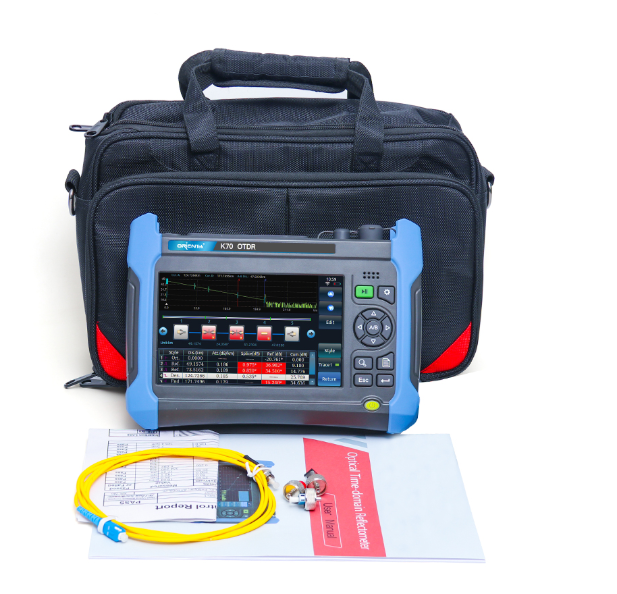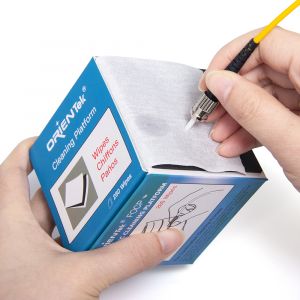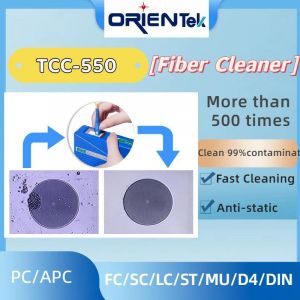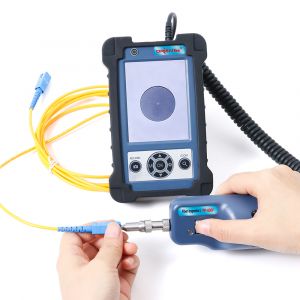Still worried about not working on FTTH equipment construction specifications?
Still tired of not understanding the construction of optical cable?
After reading this one
Keep your decathlon and everything proficient! ! !
OLT construction
● The position and orientation of the rack installation should meet the design requirements.
● The rack installation should be firmly fixed, the machine surface in the column should be flush, the rack clearance should not be more than 3mm, and the vertical deviation should not be greater than of the rack height.
● The frame should be reinforced with expansion bolts to the ground. The reinforcement of the equipment should meet the design requirements.
● In areas where the seismic intensity is above 7 degrees, the rack installation must be seismically reinforced. The reinforcement method should comply with the relevant requirements in YD 5059-2005 "Code for Seismic Design of Telecommunications Equipment Installation".
● The installation position of the subrack in the rack should meet the design requirements; the reinforcement of the subrack and the rack should meet the equipment assembly requirements.
● The subrack installation should be firm and neatly arranged. The model of the disc and the arrangement of the equipment panel should meet the design requirements, and the connectors are in good contact.
● Wall-mounted equipment should be installed firmly, horizontally and vertically, and the height of the bottom from the ground should meet the design requirements.
● The frame identification should meet the requirements of the builder. The label should be uniform, clear, clear and appropriate.
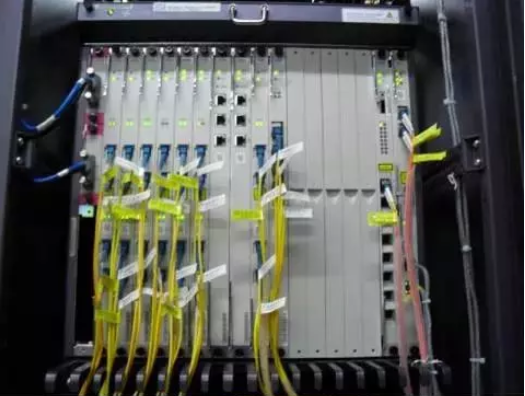
ODF construction
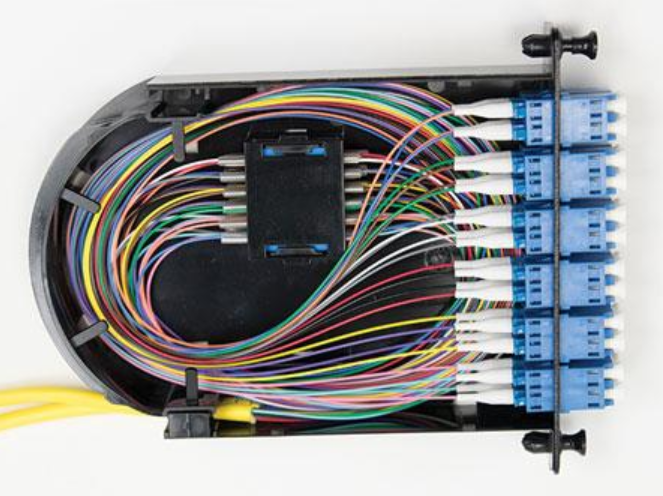
The installation of the ODF rack should meet the following requirements:
1. The installation position and machine orientation should meet the design requirements.
2. The vertical deviation of the installation should be no more than 1‰ of the height of the rack.
3. The adjacent racks should be close together, and the gap between the racks should be less than 3mm; the machine faces in the columns are flush and have no obvious bumps.
The laying of the fiber optic cable shall meet the following requirements:
1. The model specifications of the fiber optic cable should meet the design requirements, and the remaining length should not exceed 1m.
2. The layout should be neat and tidy. The inside and the shelf should be routed separately.
3. The static radius of curvature should be no less than 30mm.
The lightning protection grounding of the ODF frame should meet the following requirements:
1. ODF rack enclosure equipment protection ground should use 16mm2 or more multi-strand copper wire to connect to the dedicated equipment row of the equipment room;
2. The grounding wire of the reinforcing core of the optical cable and the metal shielding layer are first connected to the special lightning protection ground in the ODF frame, and then the multi-strand copper wire of 16mm2 or more is connected to the ODF dedicated ground row of the machine room;
3. The dedicated ODF floor in the equipment room must be separated from the dedicated floor of the equipment room, and finally connected to the total floor of the machine room;
Light delivery box construction
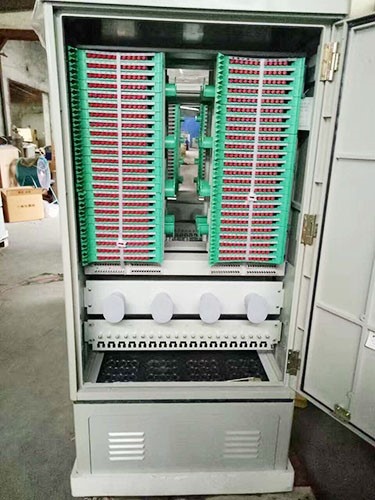
● The foundation of the optical junction box should be compacted, the wall masonry should meet the requirements of the building code, and the backfill should be compact without collapse. The height of the wall and the foundation masonry should meet the design requirements, and the plastering surface is smooth without damage or cracking. Its plaster strength is in line with the standard.
● The corner screw of the light box is stable, and the base and the light box are organically combined and flat, and are waterproof and anti-corrosive. The vertical deviation of the cabinet after installation is not more than 3mm, the outer edge of the base is larger than 150mm from the light box, and the height of the base is 300mm from the ground.
● After the installation is completed, ensure that the door lock of the light delivery box is normally opened, the door can not be deformed, and all the keys of the light delivery box should be handed in after the completion of the construction.
● Finally, after the installation, the light delivery box is clean and has no appearance problems such as damage, peeling, rust, and depression.
● Install the grounding body according to the design. The grounding body is made of two galvanized steel pipes of Φ60 length and 1700cm, and is grounded by welding with 40×4 grounding flat steel and grounding body. The length of the flat steel is determined by grounding resistance and geography. Use more than 10 squares of soft copper wire to connect with flat steel and box respectively, and the grounding resistance is not more than 10 ohms.
● The grounding of the optical cable must be reliable and securely installed. The core must be protected by a protective tube. The label of the cable is accurate. The contents of the label are two lines: the starting direction of the first line, the second number of the number of optical cables, and the number of optical cables should be staggered and tidy. Labels such as “Post House to Jihua Road Light Delivery Box 144 cores”. The label is the right size and is firmly attached.
●The light delivery box is made of 2 meters long pigtails, which are neatly arranged. The excess part of the disc is placed in the disc tray, which cannot be crossed, and the layers are distinct.
Optical fiber box construction
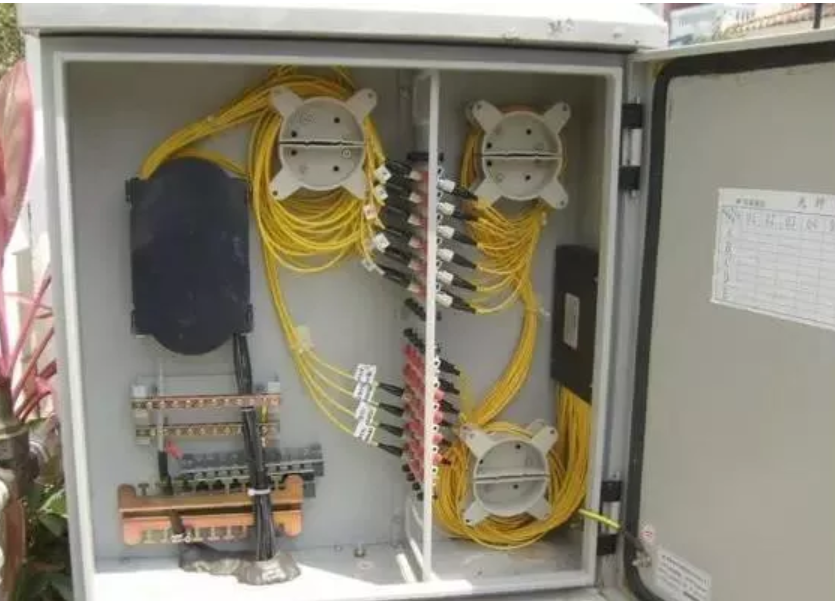
When installing the optical splitter box, it is necessary to ensure the stability of the box. There should be enough connection area in the box, and it can meet the storage and distribution of the cable during the connection. Different types of cables should have relatively independent access holes. The hole capacity should meet the requirements of full distribution. The fiber should be properly reserved in the chassis. The reserved length is convenient for the secondary connection operation. The cable should be sealed with fireproof mud.
Light splitting box construction
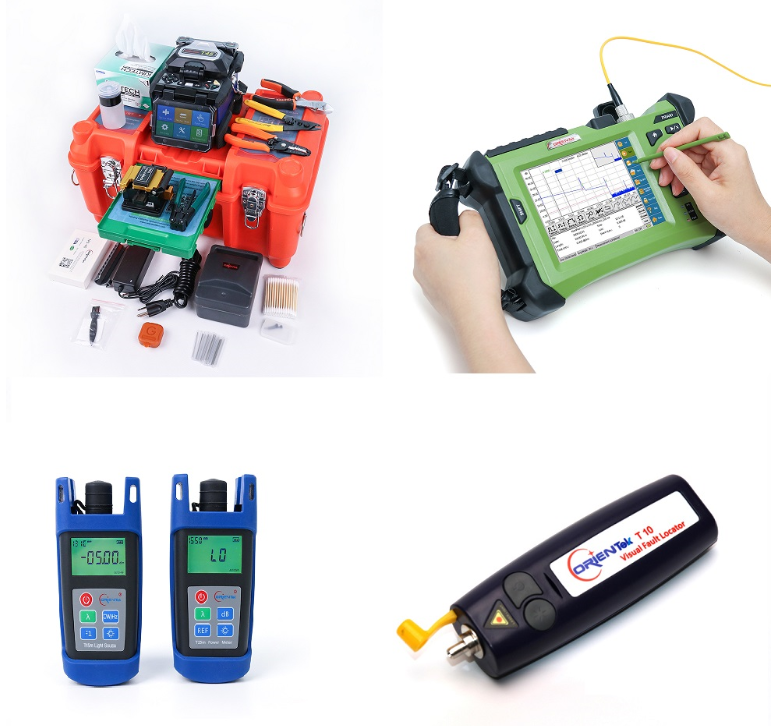
Orientek T45 Fusion Splicer + OTDR + Optic power meter + Visual Fault Locator
When constructing the optical splitter box, the tools to be used are: melter, alcohol, power meter, absolute ethanol, OTDR tester, pigtail, wire cutter, fiber cutter, diagonal pliers, level ruler, Impact drill, screwdriver, bellows, yellow tape, black tape, soft plastic belt, ring knife, fire mud, metal pliers, optical power meter, pen red light source, etc.
Inspection of the installation environment:
● First, the installation location of the fiber optic cable splitter box and the optical splitter box must be constructed according to the design documents. Generally, in the building, choose the appropriate location for the property equipment room, garage, corridor, shaft, corridor, etc.
● Secondly, when installing the fiber optic cable splitter box and the optical splitter box, it is necessary to consider the convenience of laying the next optical cable. Especially for the "thin coverage" project, it is necessary to consider how the butterfly cable is placed in the household during the second construction.
● Third, the following locations should not be installed on the wall:
◆ Unstable, disrepaired walls.
◆ Decorative exterior walls, parapet walls and other non-bearing walls.
◆ The exterior wall of temporary facilities.
◆ Affect the appearance of the city, affect pedestrian traffic and other locations that are not suitable for wall hanging.
◆ The narrow space is not conducive to opening the door and maintaining the weak electric shaft.
● Fourth, in the actual installation location, it is also necessary to pay attention to the design documents to ask whether there is a hidden danger of water leakage above the water tank, etc., whether there is a high-voltage line passing through, whether it is easy to hinder the passage of pedestrians.
● Fifthly, when installing the fiber-optic cable splitter box/box and the light splitting box/frame, the height of the bottom of the box/frame at the bottom of the box should be 1.2m~2.5m, which is specifically combined with the scene.
● Sixth, outdoor installation of fiber optic cable splitter box / box, optical splitter box / frame required box / frame bottom from the ground height should be 2.8m ~ 3.2m, specifically combined with the scene.
● Seventh, when installing the fiber optic cable splitter box/box and the light splitting box/frame in the shaft, the height of the bottom of the box/frame should be 1.0m~1.5m, which is combined with the scene.
● Eighth, if there is a problem with the installation location in the design file, it is necessary to notify the supervision unit or the construction supervisor in time, and do not blindly construct.
The installation position of the cabinet needs to meet the design requirements and be installed according to the actual situation; the installation of the cabinet requires the use of a horizontal ruler to fix the cabinet with the box fittings. After the installation, the cabinet must meet the requirements of stability and level.
Determine where the cable enters the enclosure
1. During indoor installation, the fiber optic cable can be selected from the top of the box, and it is 3-5 meters above the box to secure the back bellows.
2. When installing outdoors, the fiber optic cable must enter from the bottom of the box, and the disc should remain in the upper left or upper right side of the box for 3-5 meters. After the fixed set of bellows is protected, the cable will form a lower part of the box. A large curved drip to prevent rain from entering the cabinet along the cable.
3. Finally, after the optical cable enters the box, a plurality of loops of tape are wound at the fixed position of the cable and hung tightly, and the fireproof mud is sealed at the entrance hole of the cable.
Cable connection
1. Key points of each process:
● Construction preparation:
● The connection environment should be dustproof, waterproof and shockproof. It is best to choose to connect to the car. If it is unconditional, it should use the connection tent and set the work table and work chair.
● Arrange the continuation points and test point personnel in place.
2. Optical cable stripping:
● Check whether the cable connected to the cable is damaged or deformed before opening.
● straighten out the optical cable and make a reservation according to the regulations;
● Wipe the end of the cable with 3000mm cotton yarn, and cut off the end of the cable 200-300mm;
● sets of heat shrinkable sleeves suitable for the outer diameter of the cable;
● Confirm the A and B ends of the cable;
● to do the shield line;
● clean the grease;
● testing the insulation of the metal components of the optical cable with an insulated shaker;
● Note the depth of the infeed.
3. The cable is fixed in the connector:
● Ensure that the cable does not loosen, and the tightening screw should make the reinforcing core have a bending phenomenon;
● The fixing of the reinforcing member should pay attention to its length, so that the distance between the clamping plate of the fixing cable and the fixing reinforcement screw should be equivalent to the remaining length.
4, optical cable bundle tube stripping:
● Determine the position of the beam tube opening and stripping, pay attention to smoothing;
● cut the beam tube, pay attention to the knife;
● remove the beam tube, pay attention to uniform speed;
● wipe the grease, pay attention to clean;
● Put the bundle tube into the storage tray, and fix the ends with nylon straps. Be careful not to pull the strap too tightly;
● pre-disc fiber, so that the joint point after the connection can be placed in the fixing groove of the fiber protection tube, and the excess fiber is cut off.
5, optical cable core welding:
● Keep the workbench and the fusion splicer clean throughout the entire process;
● The optical fiber connection shall be connected one by one in order, and shall not be cross-connected.
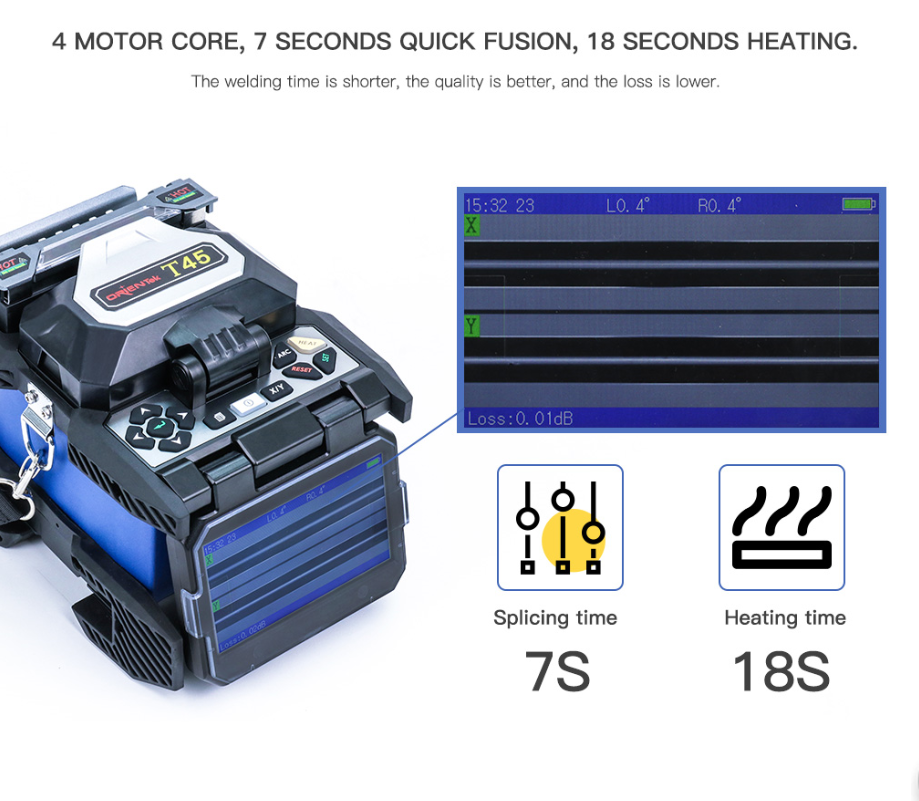
6 continuous indicator test:
● After receiving 2 cores, notify the test point test, pay attention to test two directions, two windows;
● After the test indicators are qualified, notify the connection point to thermally melt the 2-core fiber one by one.
7 Fiber protection tube heating: Move the protection tube to the middle of the fiber connector; after the tube is cooled, remove the protection tube and confirm that there are no air bubbles in the tube. The subsequent fiber fusion and hot melt are performed one by one according to the above method.
8 Fiber storage:
● step by step, pay attention to each tube immediately received;
● Fixed fiber protection tube, pay attention to safety and firmness;
● Check after containment, pay attention to bending radius, extrusion, and force;
● After the cover is closed, notify the test point to retest.
9.The cable connector box packaging:
The importance of sealing (1 to prevent the joint box from entering the water 2 directly buried joint box anti-ant);
Sealing operation (1 cable and joint box, pay attention to the sealing of the upper and lower covers of the joint box, pay attention to the uniform placement of the sealing tape).
Key points of each process
The requirements for the key points of the cable end are the same, and some of the processes are the same as the cable connection. The following explains the differences:
1. Full-test test: The test method is divided into two types: optical time domain reflectometer (OTDR) and light source optical power meter;
2. Label sticking: The end label of the optical cable mainly includes the tail fiber head label and the terminal terminal diagram. The label needs to indicate the direction of the optical cable, the number of cores and the position occupied by the terminal, etc., requiring clear writing, stable sticking and over-plastic protection.
